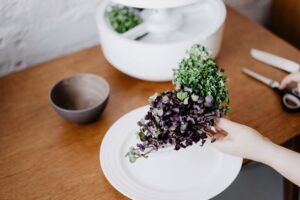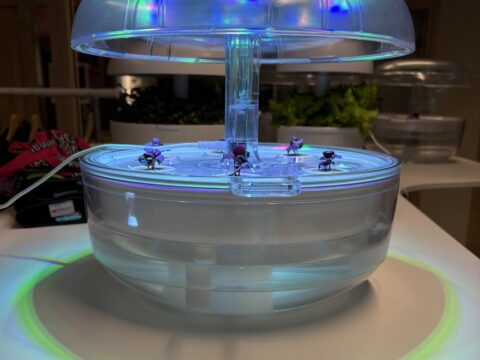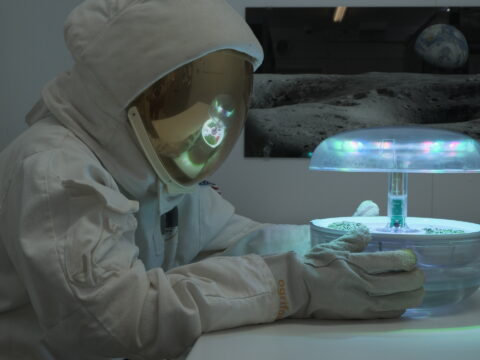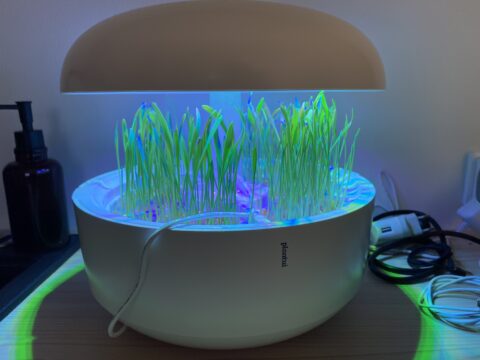Common problems with using the Plantui device
Growing herbs, green salads, chili peppers, cherry tomatoes and edible flowers in the Plantui indoor garden is normally very easy, but some issues can occur. We have listed some typical problems and questions that Plantui users have.
Common questions and problem situations
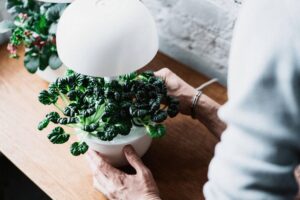
Using seeds from different growth categories
Only plants from the same or adjacent growth category should be grown in the Plantui garden. The amount of light and water is adapted automatically to the growth stage, so plants that grow at the same rate get the right kind of care for their current stage of growth. When the plants grow approximately at the same rate, each individual plant gets enough light and none are shaded by bigger ones.
A boosting light at the lowest height block can even out the amount of light.
Failing to prune plants or add a height block
The plants should be harvested with timely pruning. An alternative is to add a height block to the Plantui device to give the plants more room to grow. If the leaves are too close to the light hat, they can burn and turn brown. Just remember to eat up your plants!
Please add a height block in time! Even if the plants are still short, you should add the first height block as soon as most of the plants have their first set of leaves.
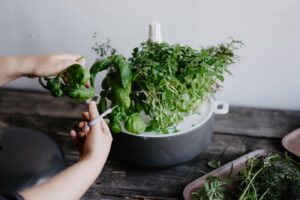
Too little water
Check the water level in the Plantui about once a week and add water at least every other week. The plants require the right amount of water and doing so will ensure the pump operates effectively. The noise of the pump gets louder when there’s insufficient water, indicated by a blinking light.
Failure to cut the roots
The roots of the plant grow as the plant grows. If the roots are too long, they can enter and break the pump. To avoid this, cut them before they reach the water bowl – you won’t damage the plants. It’s fine to let the roots reach the water tray.
Failing to clean the device after every growth cycle
It is important that you wash the bowl, water tray and plant trays in the washing machine at maximum 55 °C or by hand before you put in new seeds. This ensures that the plants have a clean platform to grow on.
You should also remove any roots that might have ended up in the pump. This is easy to do with tweezers. The upper part of the pump, the lock unit, should also be detached from the pump and wiped with a damp cloth during maintenance.
Remember to rinse all the parts carefully to get rid of all residual detergent. Cleaning the device increases its lifespan and creates the best possible conditions for the plants.
Also, change the water before starting a new growth cycle.
What if plants don’t grow?
Each seed package tells you how long the plant takes to reach germination, growth and harvest. These times are indicative and sometimes the seeds grow slower – sometimes faster. So you don’t have to worry if the plants sometimes grow a bit slower.
For example, let’s say that you planted lovage. It should germinate in two weeks. If nothing has happened in two weeks, don’t give up, wait for another two weeks. You should be able to see the miracle of growth after double the germination period at the latest.
The seeds also have their own survival strategies and those don’t always meet expectations of hobby gardeners. Sometimes the seeds become dormant, especially if they have been stored in conditions that are too warm. This means they need wait for the winter and the following spring to germinate. That’s why you should store the seeds in a cool place such as a fridge. It is also absolutely essential to keep them in a dry, airtight package.
If your Plantui plant capsules do not germinate in the device, check that the capsules are getting enough water. Access to water can be limited if the Plantui indoor garden is not standing on a level base for example. If the capsules feel moist when you touch them and the seeds still do not germinate after a long wait, they are probably dormant for some reason. If this is the case, waiting longer won’t be of any help.
We give our seeds a 100% guarantee – if the plants do not grow, contact our customer service and we will send you new capsules. But please note the best-before date at the bottom of the package.
Remember also to check that the seeds are not stuck to the sticker or have ended up under other labels of other capsules you have inserted.

Sometimes the problem is not the seeds, but the pump
Nothing germinates in dry conditions, so make sure that the germination problem is not related to the pump. It is easy to do, just simply use your finger to check. Everything should be in order if the plant capsule feels moist when you touch it. If the capsule is dry, force the pump to start (for the Plantui 6, hold your hand on the hat for about 16-20 seconds to start the pump. With the Plantui 3, press the switch under the hat for 16-20 seconds to begin).
If, after forcing it, the pump still won’t start or the plant capsules don’t get wet even when the pump is running, please get in contact and we will take a closer look.
Which plants can be grown at the same time?
Plants from the same or adjacent growth categories can be grown in the Plantui garden. Our plants are divided into four different categories: fast (3-5 weeks), average rate (5-8 weeks), slow (8-12 weeks) and over 12 weeks (chili peppers and tomatoes). Microgreens are a group of their own as they grow in 1-2 weeks.
Why did my plant become sick?
There are no plant diseases or pests in Plantui’s plant capsules because there is no soil. Sometimes plants can fall sick when in a same room as other plants which are sick or infected with pests.
If the plant falls ill, you may need to harvest the whole crop in the device. The device should then be washed carefully before starting a new growth cycle.
The plant can also suffer if it gets too much or too little nutrient. Remember to add the right amount of nutrient solution when you add water.
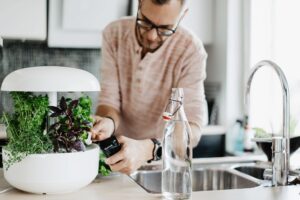
The plant started to grow but withered almost straight away
Usually this happens if you forget to add nutrient solution with water, or add too much nutrient. But if the above things are taken care of, double the germination time. If nothing happens even after that, contact our customer service and we will send you a new plant capsule.
We will also replace plants that wither after the germination stage. However, with some plants it is normal that the two first leaves wither before actual growth begins. This is the case, for example, with curly green kale.
My new pump is loud
There is no water in the pump initially, which is why it can be loud during the first couple of times it pumps. This does not damage the pump. The pump quietens down when it’s been run a few times and has taken up water.
The pump rarely starts
The pump should only start a once or a few times a day. The pumping frequency depends on the plants’ growth stage and the number of height blocks, which automatically change its operation.
Pumping is always scheduled to be done when the device is awake, in other words, when the lights are on. After the device has been asleep for 8 hours, it pumps for the first time two hours after the lights are switched on.
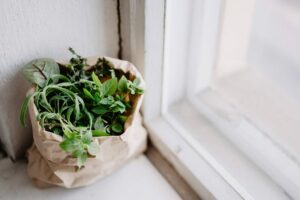
Pumping frequency depends on the growth stage.
Germination stage/no height block: the device pumps once a day for two minutes.
One height block: the device pumps twice a day for one minute at a time
Two or more height blocks: the device pumps seven times a day for one minute at a time.
The pump does not start at all
Check the pump for any obstructions, for example roots. Clean it if needed.
After this, force the pump to start by holding your hand on the light hat for about 15 seconds until the light turns blue (P6) or green (P3).
Problems with the transformer
If the light can’t be switched on at all or the lights are blinking, the problem could be caused by the transformer. You can check if the transformer is the culprit by connecting a transformer from another Plantui indoor garden. Please contact the customer service and we will help you to solve the problem.
My microgreens won’t start to grow
First check the type of water tray you have. If the water tray is grey and it has four pairs of holes (eight holes in total), you either need a new water tray or should tape over two pairs. This way the water level rises high enough to reach the microgreens tray.
Make sure that the device has been assembled correctly. When adding the microgreens tray, make sure that the watering holes are aligned and the lock unit is secured and in place. After that, put the assembly in the bowl and add the mesh plates. In order to germinate, the microgreens need to be covered for a few days with the transparent covers that came with the package. When the seeds have germinated properly, the covers can be removed.
Also, make sure that the pump operates and that the water rises to the microgreens tray. In order to ensure this, we recommend that you force the pump to start by holding your hand on the hat (Plantui 6) for about 15 seconds until the light turns blue and pumping begins.
You may need a new, white water tray for growing microgreens if
1) your current water tray is grey
2) and it has four pairs of water holes (8 holes in total)
You can order a new water tray with two pairs of holes (4 holes in total) or cover two pairs of holes with tape in your old tray.
The tape doesn’t need to be removed when the indoor garden is used for growing plants from capsules.
The smaller number of holes allows the water surface to rise to the microgreens tray.
Is the green surface on the capsule mould?
Algae will usually start to form every time there’s water, nutrients and light, especially if the weather is warm. Sometimes, dark green algae start to grow before the plants grow big enough to shade the capsule. Algae occurs naturally and is not dangerous or harmful to plants or people.
